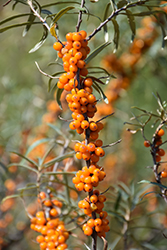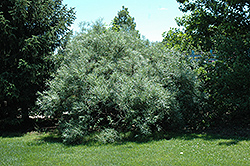Height: 25 feet
Spread: 25 feet
Sunlight:
![]()
Hardiness Zone: 3b
Other Names: Russian Sandthorn
Description:
An excellent large multi-stemmed color contrast shrub or small tree; fine, silver foliage all season long, and very showy orange berries in fall; extremely tolerant of dry, alkaline soils; only female plants produce fruit, requires a male pollinator
Ornamental Features
Sea Buckthorn is primarily grown for its highly ornamental fruit. It features an abundance of magnificent orange berries from mid fall to late winter. It has attractive grayish green deciduous foliage which emerges silver in spring. The narrow leaves are highly ornamental but do not develop any appreciable fall colour.
Landscape Attributes
Sea Buckthorn is an open multi-stemmed deciduous tree with a more or less rounded form. Its relatively fine texture sets it apart from other landscape plants with less refined foliage.
This tree will require occasional maintenance and upkeep, and is best pruned in late winter once the threat of extreme cold has passed. Gardeners should be aware of the following characteristic(s) that may warrant special consideration;
- Suckering
Sea Buckthorn is recommended for the following landscape applications;
- Accent
- Mass Planting
- Hedges/Screening
Planting & Growing
Sea Buckthorn will grow to be about 25 feet tall at maturity, with a spread of 25 feet. It has a low canopy with a typical clearance of 2 feet from the ground, and is suitable for planting under power lines. It grows at a medium rate, and under ideal conditions can be expected to live for 50 years or more.
This tree should only be grown in full sunlight. It prefers to grow in average to dry locations, and dislikes excessive moisture. It is particular about its soil conditions, with a strong preference for clay, alkaline soils, and is able to handle environmental salt. It is highly tolerant of urban pollution and will even thrive in inner city environments. This species is not originally from North America.
Disclaimer - This resource is provided for informational purposes only and does NOT reflect current availability. Inventory varies seasonally, so we cannot guarantee that every plant will be in stock at all times - please contact your favourite GardenWorks location directly for current availability. It does not include our entire inventory of plants, so be sure to visit GardenWorks to see varieties that may not be represented on this list.


